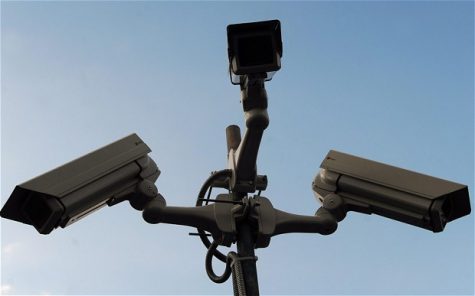CCTV: surveillance to the extreme
The UK has gone farther than most when it comes to watching their people

photo courtesy of privacyinternational.org
April 26, 2019
There are many doomsday believers that feel like we’re rapidly approaching a terrible breakdown of society. In the UK right now, many feel this way. The Orwellian situation that the UK finds themselves in is one of constant surveillance via CCTV (closed circuit television) cameras. For those who aren’t aware of the situation, CCTV is a government sponsored system of cameras that monitor the general public in every square inch of the country.
To put the situation in perspective, Shetland, a city of 23,000, contains well over 100 of these devices. If that doesn’t show the insanity of the situation, who knows what does. To put Shetland into perspective, San Francisco has a population of about 850,000 people and is home to 71 CCTV cameras, all belonging to the police department.
It’s very clear that the UK has far too many cameras. Protestors argue that the UK parliament should set limits on the number of cameras that a public body is able to operate.
It may be unclear for many how the UK became a surveillance society like that of a one-party police state. In 1994 the only closed circuit TV cameras were the ones used to monitor cashpoints at banks, but it was in that year that then prime minister John Major introduced the measures that led to the current situation.
At the launch of the government program: Looking Out For You, Major announced: “I have no doubt we will hear some protest about a threat to civil liberties. Well I have no sympathy whatsoever for so-called liberties of that kind.”
The scheme was then enthusiastically embraced by New Labor when it came to power in 1997. Tony Blair’s government announced £323million ($418 million) in grants to local authorities and police forces over four years.
The insane amount of time and effort put into this project has, according to many UK citizens, been a waste of the tax payers’ money. For every 1,000 cameras, one crime is solved per year. And for those who say it acts as a deterrent to would-be criminals, crime rates are still the same, and actually increased during the first eight years of the cameras being up. The system just isn’t doing its job.

Now, CCTV supporters like to point to the few cases where CCTVs have actually done their job and how wonderful and lifesaving they are, but these are nothing other than cherry-picked examples which are inevitable with how much the UK records its people.
There are a slew of problems that have frequently occurred with the surveillance cameras, whether that be the camera was faced away from the crime, or the footage being wiped before law enforcement can see it. Sometimes the cameras aren’t even on, which defeats the purpose of having cameras in the first place. On the rare occasion the camera is turned on, working, pointed in the right direction, and the footage isn’t scrubbed, the quality of the video is horrendous and unable to use in the court system.
The fact that the cameras are so useless makes the average £20,000 ($26,000) installation cost a detriment to society and not just a failed attempt at improved security.
All of this is only going to continue with the UK parliament planning on increasing the camera count by 2020 to an undetermined amount. While the government wants to keep constructing cameras, the general populous questions the usefulness and detrimental aspects of the CCTV system. Why the UK has gone down this road is unclear, but one can only hope it doesn’t get to that point anywhere else.






